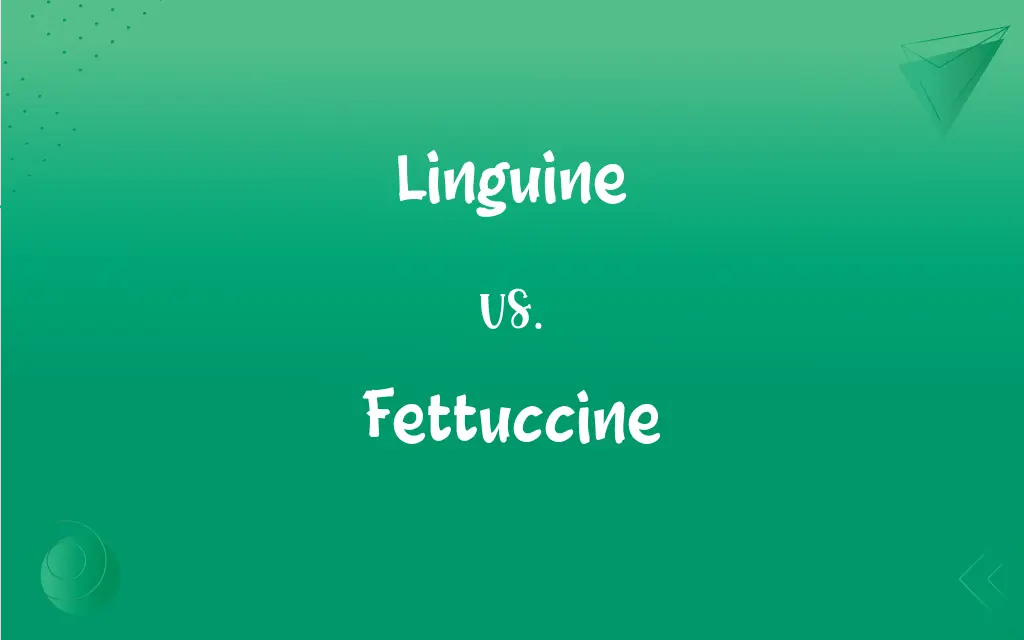Linguine vs. Fettuccine: What's the Difference?
Edited by Aimie Carlson || By Harlon Moss || Updated on October 14, 2023
Linguine is a type of pasta that is flat and narrow, resembling little tongues, while Fettuccine is similar but wider, both of which are staple items in Italian cuisine.

Key Differences
Linguine and fettuccine, both revered in the pasta world, have distinctions in form and preferred pairings. Linguine, slightly narrower, often escorts lighter sauces and seafood. This pasta type, translating to "little tongues" in Italian, elegantly carries clams or shrimp in garlic and oil. Fettuccine, with a wider presence, tends to accompany richer, creamier sauces. Its robust width allows for a hearty grasp of Alfredo or Bolognese sauces, cradling them with each twist of the fork.
From the regions of Italy, these two pasta forms emerged, linguine typically finding its roots in Liguria. In this coastal region, seafood is abundant and thus linguine marries perfectly with sauces derived from the ocean's offerings. On the other hand, fettuccine often graces tables in Rome and Tuscany where the sauces bear a heavier, creamier texture and ingredients.
Diners may note that linguine offers a more delicate eating experience. Its slender form requiring a refined twirl of the fork, typically seen gracefully paired with pesto or simple olive oil concoctions. Fettuccine, on the contrast, demands a sturdy twirl, its width playing host to robust and often meaty accompaniments, providing a heartier meal that stands firm on the plate and the palate.
The culinary world adores both linguine and fettuccine for their versatility and ability to host a myriad of ingredients. Linguine finds its strength in simplicity, often allowing the ingredients it is paired with to shine. Fettuccine acts as a formidable base for sturdier, heavier sauces, holding its own in a rich, culinary dialogue.
Choosing between linguine and fettuccine often boils down to sauce preference and desired dining experience. Whether indulging in the light, sea-kissed offerings atop linguine or savoring the rich, creamy embrace of a fettuccine Alfredo, both pasta types promise a delightful Italian gastronomy journey.
ADVERTISEMENT
Comparison Chart
Width
Narrower, about 2-3mm
Wider, approximately 6.5mm
Best Paired With
Lighter sauces and seafood
Heavier, creamier, and often meaty sauces
Origin
Typically associated with Liguria
Common in Rome and Tuscany
Eating Experience
Delicate, often with simple sauces
Hearty, commonly with robust sauces
Common Dishes
Linguine alle Vongole (with clams)
Fettuccine Alfredo
ADVERTISEMENT
Linguine and Fettuccine Definitions
Linguine
Linguine is a narrow, flat pasta, popular in Italian cuisine.
Her favorite Italian dish is linguine with clams.
Fettuccine
Originating from Rome, fettuccine is prevalent in Tuscan and Roman cuisine.
When in Rome, he always orders the fettuccine Alfredo from the local trattoria.
Linguine
Originating from Liguria, linguine often pairs with seafood or pesto.
The chef prepared a dish of linguine tossed in a freshly made basil pesto.
Fettuccine
Known for its hearty nature, fettuccine often pairs with robust and creamy sauces.
The chef's special was a hearty beef ragu served over al dente fettuccine.
Linguine
Linguine tends to accompany lighter, often oil-based sauces.
She chose linguine to delicately uphold the white wine and garlic sauce.
Fettuccine
The name "fettuccine" translates to “little ribbons” in Italian, indicating its shape.
She admired the fettuccine, the little ribbons beautifully enveloped in tomato sauce.
Linguine
Typically made from durum wheat semolina, linguine holds a firm, al dente texture.
The linguine, made from fine durum wheat, provided a satisfying bite.
Fettuccine
Fettuccine is a flat, wide Italian pasta traditionally made from egg and flour.
The creamy Alfredo sauce clung perfectly to the freshly made fettuccine.
Linguine
Linguine’s name, translating to "little tongues," reflects its slender form.
Linguine, resembling little tongues, curled around the fork elegantly.
Fettuccine
Fettuccine is typically cut into a width approximately 6.5mm wide after being rolled thin.
Homemade fettuccine, freshly cut, waited to be plunged into the boiling water.
Linguine
Pasta in long, flat, thin strands.
Fettuccine
Pasta in narrow flat strips.
Linguine
Of pasta, cut from a sheet, not as wide as tagliatelle.
Fettuccine
A dish made with such strips of pasta.
Linguine
Pasta in long slender flat strips
Fettuccine
Long, flat ribbons of pasta, cut from a rolled-out sheet; identical in form to tagliatelle.
Fettuccine
Pasta in flat strips wider than linguine
FAQs
What defines fettuccine?
Fettuccine is a wide, flat pasta from Italy, often associated with hearty, creamy sauces.
What is linguine?
Linguine is a narrow, flat pasta originating from Italy, traditionally used with seafood or light sauces.
Which is wider, linguine or fettuccine?
Fettuccine is wider than linguine.
Is fettuccine traditionally paired with heavier sauces?
Yes, fettuccine is commonly paired with hearty, creamy, or meaty sauces like Alfredo or Bolognese.
Which pasta type is best for a light summer dish, linguine or fettuccine?
Linguine, often paired with light, oil-based sauces, might be preferable for a lighter summer dish.
Is linguine always made with seafood?
No, while linguine pairs well with seafood, it can also be served with various other sauces.
Which sauces typically accompany linguine?
Linguine is often paired with lighter, seafood-based or pesto sauces.
What is fettuccine Alfredo?
Fettuccine Alfredo is a dish made with fettuccine and a rich sauce of butter, Parmesan cheese, and sometimes cream.
Can fettuccine be used as a substitute for linguine and vice versa?
Yes, they can substitute each other, but note that the sauce pairing might need adjustment due to their width difference.
Which is traditionally made with eggs, linguine or fettuccine?
Fettuccine is traditionally made with eggs.
Are linguine and fettuccine regional pasta types in Italy?
Yes, linguine is associated with Liguria, while fettuccine is common in Rome and Tuscany.
What is the primary ingredient in linguine?
The primary ingredient in linguine is typically durum wheat semolina.
Is fettuccine usually handmade or machine-made?
Fettuccine can be either handmade or machine-made, with both methods popular in Italy.
Can both linguine and fettuccine be used in a pasta bake?
Yes, both can be used, but fettuccine's width might provide a heartier bite in a bake.
What does “linguine” mean in Italian?
Linguine means "little tongues" in Italian.
What is the translation of “fettuccine” in English?
Fettuccine translates to "little ribbons" in English.
Do linguine and fettuccine have different cooking times?
Yes, due to their size difference, fettuccine might take slightly longer to reach al dente texture than linguine.
Can I prepare a vegetarian dish with fettuccine?
Absolutely, fettuccine can be paired with a variety of vegetarian sauces.
Is it common to add vegetables to linguine dishes?
Yes, linguine dishes often feature vegetables, especially in seafood or pesto varieties.
What is a popular linguine dish?
Linguine alle vongole, made with clams, is a well-known linguine dish.
About Author
Written by
Harlon MossHarlon is a seasoned quality moderator and accomplished content writer for Difference Wiki. An alumnus of the prestigious University of California, he earned his degree in Computer Science. Leveraging his academic background, Harlon brings a meticulous and informed perspective to his work, ensuring content accuracy and excellence.
Edited by
Aimie CarlsonAimie Carlson, holding a master's degree in English literature, is a fervent English language enthusiast. She lends her writing talents to Difference Wiki, a prominent website that specializes in comparisons, offering readers insightful analyses that both captivate and inform.
































































